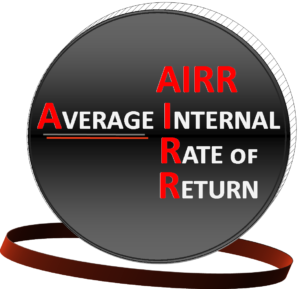A new approach to investment valuation and decision-making and a complete solution to the Internal Rate of Return’s flaws
Access my YouTube channel

What is the Average Internal Rate of Return (AIRR)?
The Average Internal Rate of Return (AIRR) is an average-based approach which enables computing rates of return for any kind of investments (project, fund, portfolio, firm) and provide a simple and intuitive link with the net present value by decomposing value creation into project scale (the overall capital invested) and economic efficiency (the rate of return over and above the cot of capital)
Does the AIRR approach generate a specific rate of return?
Not exactly, it generates a class of rates of return. A specific rate of return is found by specifying the capital base on which the rate is applied.
How can I compute AIRR?
AIRR can be computed in four equivalent ways:
(i) ratio of (total) return to invested capital
(ii) weighted mean of the holding period rates, weighted by the discounted values of the asset’s capital values
(iii) ratio of present value of incomes to present value of capitals multiplied by the conversion factor (1+cost of capital)
(iv) sum of NPV per unit of invested capital and cost of capital
Let \(i_t\) be the holding period rate in a generic period, \(c_{t-1}\) the capital committed in that period, \(r\) the cost of capital, \(n\) the length of the investment. Let \(I_t=i_t\cdot c_{t-1}\) be the investment’s profit in the same period.
(i) is formally described as
$$ AIRR=\frac{I_1+I_2(1+r)^{-1}+\ldots +I_n(1+r)^{-(n-1)}}{c_0+c_1(1+r)^{-1}+c_2(1+r)^{-2}+\ldots +c_{n-1}(1+r)^{-(n-1)}}$$
(ii) is formally described as
$$AIRR=\frac{i_1 c_0 +i_2 c_1 (1+r)^{-1}+\ldots i_n c_{n-1} (1+r)^{-(n-1)} }{c_0 + c_1 (1+r)^{-1}+\ldots + c_{n-1} (1+r)^{-n} }$$
(iii) is formally described as
$$ AIRR=\frac{I_1(1+r)^{-1}+I_2(1+r)^{-2}+\ldots +I_n(1+r)^{-n}}{c_0+c_1(1+r)^{-1}+c_2(1+r)^{-2}+\ldots +c_{n-1}(1+r)^{-(n-1)}}\cdot (1+r)$$
(iv) is a computational shortcut and is formally described as
$$AIRR=r+\frac{NPV(1+r)}{c_0+c_1(1+r)^{-1}+c_2(1+r)^{-2}+\ldots +c_{n-1}(1+r)^{-(n-1)}}$$
where NPV denotes the net present value of the investment.
Pro forma financial statements are available for my project. May I use the pro forma book values as invested capital?
Yes. In this case, you will have a Book AIRR (BAIRR). Specifically, if you use invested capital, you will compute the average ROI, if you use equity, you will have the average ROE.
Market values are available for my portfolio investment. May I use them as invested capital?
Yes.
The amortization plan of my loan is available. May I use the outstanding debt as invested capital?
Yes.
What if capital values are not available and I cannote estimate them?
You can use the intrinsic or economic value. Economic value is equal to the discounted sum of prospective cash flows:
$$c_t=\frac{f_{t+1}}{1+r} +\frac{f_{t+2}}{(1+r)^2}+\ldots +\frac{f_{n}}{(1+r)^{n-t}}.$$
In this case, you will compute the “Economic AIRR” (EAIRR).
I see that (i)-(iii) represent the return per unit of total capital invested. Can the AIRR provide a metric that measures the return per unit of initial investment?
Yes. One can compute the return per unit of initial investment by exploiting the shortcut (iii):
$$AIRR (c_0)= r+\frac{NPV(1+r)}{c_0}.$$
More generally, AIRR offers you a set of return rates referred to different capital bases: total capital, average capital, total contribution, etc. We denote as \( AIRR(x)\) the AIRR on capital base \(x\):
$$AIRR (x)= r+\frac{NPV(1+r)}{x}.$$
I know that the internal rate of return (IRR) may not exist or may be multiple. Does AIRR have these problems?
No, the AIRR approach generates a nonempty class of rates of return, so there is no problem of existence. And any rate of return in the AIRR class is uniquely associated to its capital base. The AIRR notion does not incur the numerous flaws the IRR notion incurs (click here for a compendium of 18 flaws of the IRR).
Is AIRR consistent with net present value (NPV)?
Yes, whatever capital base \(x\) you choose (total capital, initial investment, total contribution etc.) the NPV can be obtained as
$$ NPV=x\cdot \frac{AIRR(x)-r}{1+r},$$
so NPV is positive if and only if the rate of return is greater than the cost of capital. Note that NPV is decomposed into two components: The capital base and the economic efficiency.
What if it turns out that the total capital is negative?
In that case , the project represents a net borrowing (a liability), so the AIRR is not an investment rate, but a financing rate. Therefore, NPV is positive if and only if the financing rate is smaller than the cost of capital, which represents the maximum borrowing rate acceptable by investors.
Is the AIRR approach applicable in practice?
Of course, it has been devised for real-life applications.
How can I learn more about AIRR?
There are three ways (not mutually exclusive):
- Go to my YouTube Channel
- Read my papers on AIRR
- Contact me and ask for details (magni@unimo.it)
- Attend my lectures on financial and corporate investment decisions and engineering economics
Which papers are devoted to AIRR?
There are several papers on AIRR. Click on the journal’s title to download:
- Magni C.A. 2010. Average Internal Rate of Return and investment decisions: a new perspective. The Engineering Economist, 55(2), 150‒181.
- Altshuler D., Magni C.A. 2012. Why IRR is not the rate of return on your investment: Introducing the AIRR to the Real Estate community. Journal of Real Estate Portfolio Management, 18(2), 219‒230.
- Magni C.A. 2013. The Internal-Rate-of-Return approach and the AIRR paradigm: A refutation and a corroboration. The Engineering Economist, 58(2), 73‒111.
- Magni C.A. 2013. Generalized Makeham’s formula and economic profitability. Insurance: Mathematics and Economics, 53(3) (November), 747‒756.
- Guerra M.L., Magni C.A., Stefanini L. 2014. Interval and fuzzy Average Internal Rate of Return for investment appraisal, Fuzzy Sets and Systems, 257,217‒241.
- Magni C.A. 2014. Mathematical analysis of average rates of return and investment decisions: The missing link. The Engineering Economist, 59(3), 175‒206.
- Magni C.A. 2014. Arithmetic returns for investment performance measurement. Insurance: Mathematics and Economics. 55 (March), 291‒300.
- Pressacco F. Magni C.A., Stucchi P. 2014. A quasi-IRR for a project without IRR. Frontiers in Finance and Economics, 11(2), 1‒23.
- Magni C.A. 2015. Investment, financing and the role of ROA and WACC in value creation, European Journal of Operational Research, 244(3) (August), 855‒866.
- Cuthbert J., Magni C.A. 2016. Measuring the inadequacy of IRR in PFI schemes using profitability index and AIRR. International Journal of Production Economics, 179, 130-140.
- Magni C.A. 2016. Capital depreciation and the underdetermination of rate of return: A unifying perspective. Journal of Mathematical Economics, 67 (December), 54-79.
- Magni C.A., Veronese P., Graziani R. 2017. Chisini means and rational decision-making: Equivalence of investment criteria. Mathematics and Financial Economics, 12(2), 193-217.
- Marchioni A., Magni C.A. 2018. Investment decisions and sensitivity analysis: NPV-consistency of rates of return, European Journal of Operational Research. 268(1) (July), 361-372.
- Cuthbert J, Magni CA. 2018. Some problems of the IRR in measuring PEI performance and how to solve it with the pure-investment AIRR. Journal of Performance Measurement. 22(2) (Winter), 39-50.
I search for a rate of return which is internal, that is, it does not depend on the cost of capital. Can the AIRR approach be of some help?
Yes, one can use the Aggregate Return On Investment (AROI) approach, a variant of the AIRR approach. Here is a list of papers devoted to AROI:
- Magni C.A. 2011. Aggregate Return On Investment and investment decisions: a cash-flow perspective. The Engineering Economist, 56(2), 181–182.
- Magni C.A. 2015. Aggregate Return On Investment for investments under uncertainty, International Journal of Production Economics, 165 (July), 29–37.
- Magni C.A. 2015. An average-based accounting approach to capital asset investment: The case of project finance, European Accounting Review, DOI: 10.1080/09638180.2015.1009143.
- Althsuler D., Magni C.A. 2015- Introducing Aggregate Return on Investment as a solution to the contradiction between some PME metrics and IRR. Journal of Performance Measurement, 20(1) (Fall), 48‒56.
- Cuthbert J., Magni C.A. 2016. Measuring the inadequacy of IRR in PFI schemes using profitability index and AIRR. International Journal of Production Economics, 179, 130-140.
- Althsuler D., Magni C.A. 2015. Introducing Aggregate Return on Investment as a solution to the contradiction between some PME metrics and IRR. Journal of Performance Measurement, 20(1) (Fall), 48–56.
- Magni C.A. 2015. Aggregate Return On Investment for investments under uncertainty, International Journal of Production Economics, 165 (July), 29–37.
- Magni C.A. 2016. An average-based accounting approach to capital asset investment: The case of project finance, European Accounting Review, 25(2), 275-286.
|
“Eugene L. Grant” award- granted by the Engineering Economy Division of the American Society for Engineering Education (ASEE)
Executive summary, in Industrial Engineer, September 2013

The AIRR paradigm is a comprehensive approach to investment evaluation. It is invaluable for ex-ante applications, where assessment of future economic profitability is of paramount importance to investors and their managers. When used ex-post, AIRR provides performance measurement professionals with a methodology that is both theoretically rigorous and practically easy-to-use. <read more>
Dean Altshuler, Ph.D., CFA, Bard Consulting LLC
————————————————————–
The technical problem of evaluation of investments is, at the same time, crucial and controversial. The improper use of the IRR has often hidden the right solution. The AIRR approach overcomes these problems and provides all us with an efficient tool to drive investment decisions. A highly recommended point of view.
Lorenzo Peccati, “Bocconi” University – editor of the European Journal of Operational Research (2002-2014)
————————————————————–
The AIRR is a more appropriate formulation of the notion of rate of return than the traditional IRR approach. Most of the difficulties associated with IRR can be bypassed by adopting the AIRR. The AIRR is an important contribution to the financial literature and the practice of finance.
Gordon Hazen, Northwestern University – Associate Editor of Management Science (1989-1994), Operations Research (1994-2005) and Decision Analysis (2003 to present)
We were approached by Thierry Renard and Carlo Alberto Magni and were intrigued by what they had to say: a new approach to calculating an internal rate of return. What’s more, they were illustrating the application of the Average Internal Rate of Return (“AIRR”) using Excel and the FAST Standard.
So while we are still evaluating what impact AIRR might have on our own financial modelling, we are very pleased to share their work as a guest blog.
F1F9 (financial modelling and training, model build, risk management and review) |


